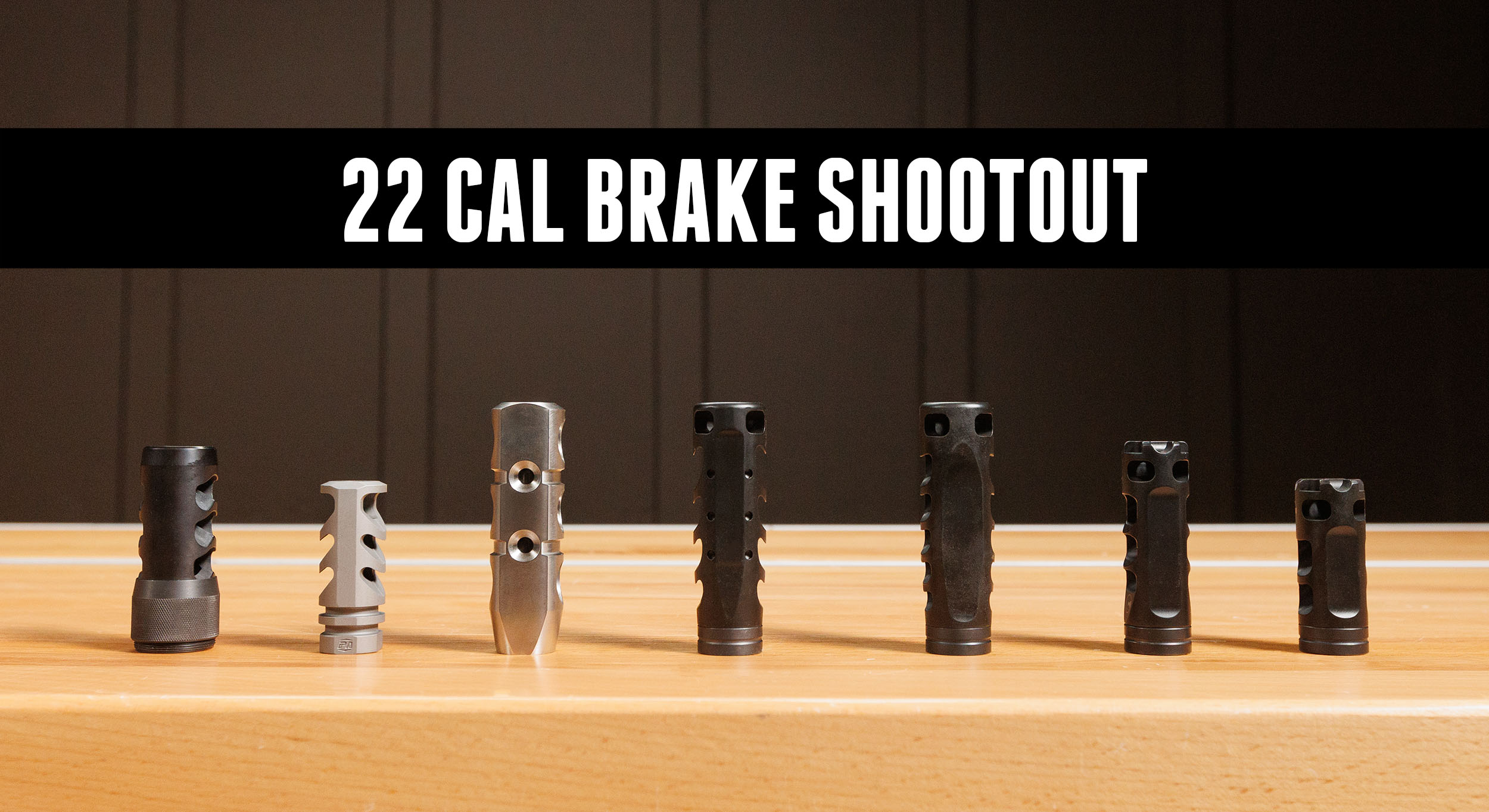I previously used our recoil rig to do an in-depth .30 cal muzzle brake shootout. Now I’m doing the same for .22!
Disclaimer
Ultimate Reloader LLC / Making with Metal Disclaimer: (by reading this article and/or watching video content you accept these terms). The content on this website (including videos, articles, ammunition reloading data, technical articles, gunsmithing and other information) is for demonstration purposes only. Do not attempt any of the processes or procedures shown or described on this website. All gunsmithing procedures should be carried out by a qualified and licensed gunsmith at their own risk. Do not attempt to repair or modify any firearms based on information on this website. Ultimate Reloader, LLC and Making With Metal can not be held liable for property or personal damage due to viewers/readers of this website performing activities, procedures, techniques, or practices described in whole or part on this website. By accepting these terms, you agree that you alone are solely responsible for your own safety and property as it pertains to activities, procedures, techniques, or practices described in whole or part on this website.
About the Brakes
During our last test, we learned a number of interesting things, including that bullet to brake bore clearance didn’t matter as much as we expected. I tested this further with Salmon River Solutions. Whenever we bring out the recoil rig, we always learn something new.
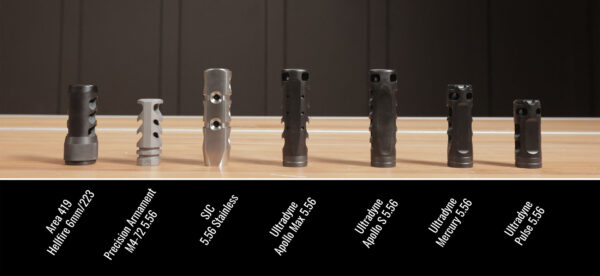
For this test, we had seven brakes from four different manufacturers: the Area 419 Hellfire 6mm/.223, Precision Armament M4-72 5.56, SJC 5.56 Titan Stainless, Ultradyne Apollo Max 5.56, Ultradyne Apollo S 5.56, Ultradyne Mercury 5.56, and Ultradyne Pulse 5.56.
I started by measuring bullet clearance using pin gauges. Bore diameter measured with a pin gauge – .224 (bullet diameter) = bullet clearance

Results ranged between 0.035” and 0.055”, with the SJC 5.56 stainless being the tightest and the Precision Armament M4-72 being the loosest. The recoil rig allows us to measure rearward forces at the buttstock, collecting 20,000 samples/second. This incredible tool allows us to truly quantify recoil in a meaningful and comparable way.
About the Rifle and Ammo
For this test, I used my .22-250 Winchester Model 70 in a Boyds Pro Varmint stock with an Athlon Argos BTR Gen 2 scope. I used the same ammunition with every brake, Hornady 52 grain HPBTs loaded over 38.0 grains of H380.
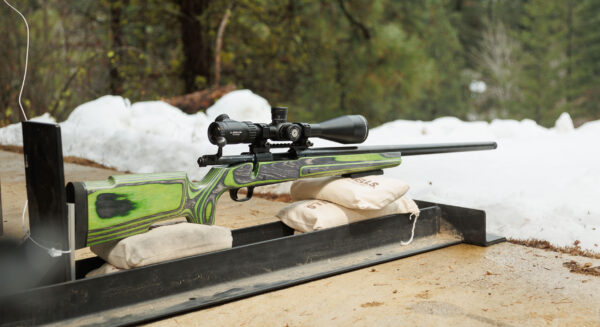
I originally threaded the muzzle for ⅝ x 24”, so I had to remove some of the barrel and rethread it ½ x 24” in order to direct thread all of the brakes with the exception of the Area 419’s Hellfire. I only had a ⅝ x 24” taper adapter for this brake, so I had to use a step up. It did not affect functionality.
Test Results
I compared each of the brakes to the bare muzzle using the same gun and ammo. Peak force with the bare muzzle was approximately 300 pounds.

All of the brakes cut this peak force drastically, by 50% or more!
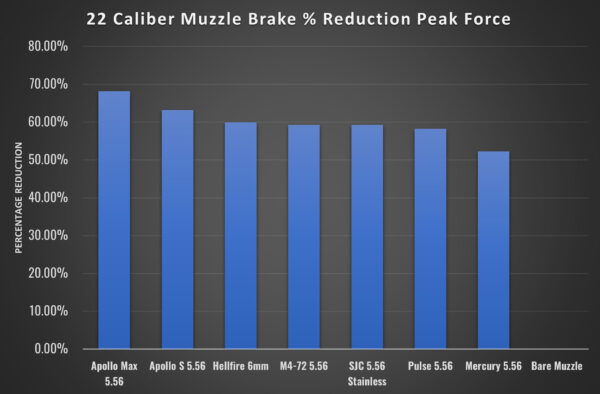
The Ultradyne Mercury 5.56 had the second greatest peak force compared to bare muzzle. I was concerned at first as it didn’t have a nice rounded profile, but as I tested more brakes I realized the hills and valleys were characteristic of all of the .22 brakes with this setup. Continuing on in order of decreasing peak force, the Ultradyne Pulse 5.56 followed the Mercury, then the SJC 5.56 Titan Stainless, PA M4-72, Area 419 Hellfire .223, Apollo S and Apollo MAX. The Ultradyne Apollo MAX 5.56 won our shootout, with the lowest peak forces. This largely mimics our .30 cal brake shootout, where the Ultradyne Apollo MAX 7.62 came out on top.
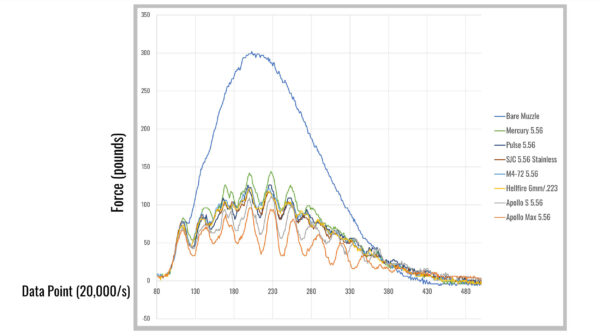
I also noticed that the only brake with noticeable blast was the SJC 5.56 Titan. This is subjective and I wasn’t in the proper shooting position, but I thought it was worth noting.
All of this happens incredibly quickly, with elapsed time ranging from 0.012 seconds to 0.016 seconds.

To capture the entire recoil event, you need to look at impulse, the entire area under the curve. The software I wrote allows us to capture this.
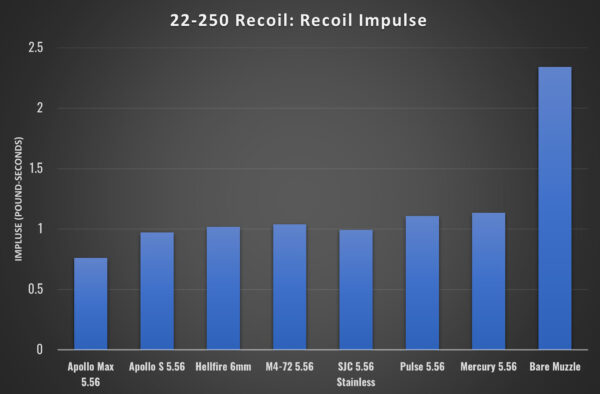
Recoil impulse results largely matched peak forces results. All of these brakes did an exceptional job at reducing recoil compared to the bare muzzle.
Conclusion
This test revealed that all the brakes dramatically reduced recoil, but the Apollo MAX 5.56 and Apollo S 5.56 really stood out. The former reduced peak forces by over 68%! Peak forces and total impulse also correlated well across the board. Looking forward, I’d like to test muzzle rise/compensation as well as sound level and shock/blast — I just have to find a way to capture it.

Get the Gear
Athlon Argos BTR Gen 2 8-34×56
Hornady 52 grain HPBT Bullets at Midsouth Shooters Supply
Hodgdon H380 at Midsouth Shooters Supply
Don’t miss out on Ultimate Reloader updates, make sure you’re subscribed!
Thanks,
Gavin Gear
